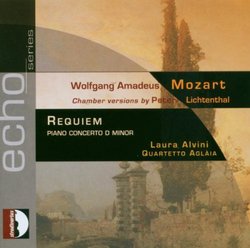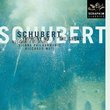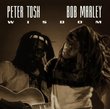| All Artists: Wolfgang Amadeus Mozart, Laura Alvini Title: Mozart: Requiem; Piano Concerto in D Minor Members Wishing: 0 Total Copies: 0 Label: Stradivarius Original Release Date: 1/1/2006 Re-Release Date: 7/11/2006 Genre: Classical Styles: Opera & Classical Vocal, Chamber Music, Forms & Genres, Concertos, Historical Periods, Classical (c.1770-1830), Early Music, Instruments, Keyboard Number of Discs: 1 SwapaCD Credits: 1 UPC: 8011570110121 |
Search - Wolfgang Amadeus Mozart, Laura Alvini :: Mozart: Requiem; Piano Concerto in D Minor
 | Wolfgang Amadeus Mozart, Laura Alvini Mozart: Requiem; Piano Concerto in D Minor Genre: Classical
Peter Lichtenthal (1780-1853), born in Mozart?s lifetime, became a passionate advocate of his music. Lichtenthal was a doctor by profession, but also a composer and musicologist who wrote an important early biography of Mo... more » |
Larger Image |
CD Details
Synopsis
Album Description
Peter Lichtenthal (1780-1853), born in Mozart?s lifetime, became a passionate advocate of his music. Lichtenthal was a doctor by profession, but also a composer and musicologist who wrote an important early biography of Mozart in 1816. Lichtenthal transcribed several Mozart compositions for string quartet, string quintet, and other ensembles. His transcription of the Requiem Mass for string quartet was designed to preserve Mozart?s great melodies in a domestic setting, before the existence of sound recordings. Likewise the beloved Piano Concerto No. 20, transformed here into a version that could be played in many a bourgeois or upper middle class drawing room in the early nineteenth century. The Aglàia Quartet is one form of the larger Ensemble Aglàia, founded in Milan in 1992 and named after one of the three Graces from Greek mythology. They specialize in Baroque and pre-classical music performed on original instruments. They are joined here by Laura Alvini, one of Italy?s best-known keyboard artists for early music, both on harpsichord and fortepiano.
Similar CDs
| Peter Tosh, Bob Marley Wisdom Genres: International Music, Pop Label: Recall Records UK | |
| Ramey, Handel, Mozart Opera Arias Genre: Classical Label: Polygram Records | |

 Track Listings (17) - Disc #1
Track Listings (17) - Disc #1

